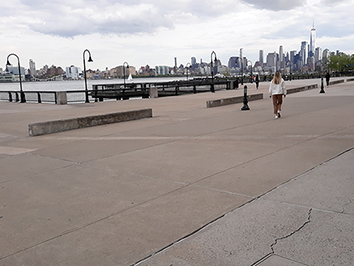Hoboken parks established in an earlier era are full of shade trees, but for the past 20 years, the City has squandered opportunities for more

The expanse of concrete at the north end of Maxwell Place Park, devoid of trees.
FBW | April 28, 2023
Arbor Day is celebrated today, April 28th. This national holiday proclaims the many benefits of trees. Shade trees are especially important for our urban environment. They lower temperatures and provide shade on hot summer days. They absorb groundwater, reducing the amount of rainwater flowing into the sewer system. Trees play a vital role in curtailing air pollution. They capture carbon while releasing life-sustaining oxygen. In addition, trees can be aesthetically pleasing and provide a connection with nature.
Most of Hoboken’s existing tree canopy was established in an earlier era. Hoboken’s original parks — Church Square, Stevens, Elysian and Columbus — all built more than 100 years ago, have generous tree canopies. Most of these trees are London plane trees but also include Norway maples, horse chestnuts and lindens. In the 1990s, hundreds of shade trees were planted at Hoboken’s South Waterfront, garnering recognition from the American Society of Landscape Architects. This landscape design included a grove of London plane trees at Pier A Park and multiple rows of London plane trees and Chinese elms along the walkway from Newark to Fourth Street.
But over the past 20 years, Hoboken has missed numerous opportunities to add to its shade tree inventory. Castle Point Park is a barren landscape along Hoboken’s central waterfront. At Maxwell Place Park, an expanse of concrete at the north end is devoid of trees. Ten years ago, the renovation of Sinatra Park replaced the London plane trees along the walkway with a small-statured, ornamental variety. Southwest Resiliency Park is essentially a plaza with few shade trees.
Last year, the City of Hoboken restarted the Sinatra Drive Project along the waterfront from Fourth to Eleventh Streets. This was a project that begged for street trees but the City relied solely on Kimley-Horn, an engineering firm specializing in roadways. To fill the vacuum, the Fund for a Better Waterfront (FBW) hired Arnold Associates Landscape Architects who provided to the City plans for rows of shade trees and details for proper planting techniques.
Campaigns across the country have stressed the importance of establishing tree canopies in our urban areas. In New York City, former Mayor Michael Bloomberg met his target for planting a million trees as did the former mayor of Los Angeles, Antonio Villaraigosa. Over a 5-year period, Seattle, Washington has set a goal of planting 48,000 trees on public and private lands. Detroit, Michigan will plant 75,000 trees over the next 5 years. The Inflation Reduction Act, passed by Congress last year, designated a historic $1.5 billion for the federal Forest Service Urban and Community Forestry Program over the next decade.
FBW’s original Plan for the Hoboken Waterfront produced in 1990, included rows of shade trees along Sinatra Drive and the proposed continuous park at the Hudson River. The inclusion of trees that will eventually form a canopy along streets and within parks should be a fundamental element in park designs. FBW has advocated the same for Union Dry Dock where the planning process is currently underway.
Related Articles
Roots Over the River – Landscape Architecture
Sustainable trees for sustainable cities – Arnoldia
Related Links
A green + blue vision for Union Dry Dock
An innovative planting technique for urban trees
Making the “green circuit” greener along Hoboken’s waterfront
An opportunity to upgrade the long neglected central waterfront
Hoboken’s model for trees in urban design
In praise of London plane trees in London . . . and in Hoboken
The transformation of Hoboken’s waterfront
Mapping New York City’s trees

